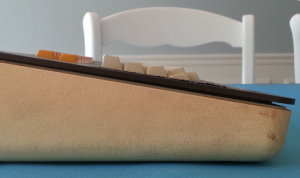I disagree with jacobolus on the keytop angle. I believe it is important to have a close to horizontal surface on the home row keycaps, with angles on the keycaps on other rows such as to form a continuous curve which matches finger movement. This leads to the least effort and fatigue when typing compared to having ridges you need to lift your finger over when moving to higher / lower rows.
I posted this in the SA profile discussion thread:
"The reasons I consider the less back-angled keycaps to be better is it reduces the finger / hand / arm movements required to move between rows (since you don't have to lift over the ridge) and thus allows more efficient and less fatiguing typing. Particularly when you also add some nice angling of the keycap tops as in sculpted SA. It also provides good finger movement direction when pressing, at least on rows 1 to 4. I do think there could be a hair more difference in height between rows to allow a more continuous curve between keytop angles from row 1 through 4 (with rows 2 and 4 still identical to each other, with mirrored angles), but it is close enough to ideal not to matter much.
It really is the only profile that truly feels "right" for me on a properly angled and positioned board of all the ones I've tried.
Anopther reason I like SA caps is their mass. Row 3 caps weigh 1.95g, more than twice what Row 3 DCS caps weigh (0.78g). It really give a nice feeling when typing, IMHO."
https://geekhack.org/index.php?topic=63052.msg1536871#msg1536871Most current keycap profiles (Cherry, OEM, DCS, etc) were designed to match existing keytop angles and heights from older boards which had a steeper angle than many modern boards (like typewriters and terminal keyboards, and which were used differently too - higher desk, steeper arm angle, etc).


It's better ergonomically to have a flatter board with lower arms about parallel to the ground and a keyboard angle somewhere between very shallow up angle to very shallow down angle (angled away from you), depending on the keyboard height, etc.
This is why flat laptop "chiclet" keyboards are actually quite okay to type on, despite the lack of contouring. IMHO, the best profile for proper ergonomic posture and desk setup is fully sculptured SA profile.